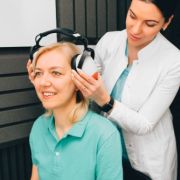
Misophonia
Misophonia is an extreme emotional and physical response to seemingly innocuous, repetitive sounds like chewing, lip-smacking, and even breathing. Translated from Greek as “hatred of sounds,” people with the condition experience a fight-or-flight response to these noises, along with physical tension, disproportionate anger, and hatred or disgust toward the person responsible for the triggering noise. Even noises made by pets can be provoking; also, sometimes just seeing a reminder of the sound can be just as upsetting as the sound itself. Other emotional reactions that accompany misophonia are rage, anxiety, panic, fear, irritation, and distress.

Misophonia has only recently gained traction as an area of study, and many aspects of the condition remain a mystery. While the exact prevalence is unknown, one study revealed that one in six people have experienced misophonia. Symptoms typically begin in childhood or adolescence and increase in severity, but the condition can also emerge later in life.
The causes of misophonia are still unclear, but fMRI studies suggest the disorder is associated with overactive brain connections between auditory pathways and regions responsible for regulating emotions. Onset of symptoms can start between ages 9 and 13. Researchers have found that areas in the brain, known for fear and long-term memory, are activated in sufferers when hearing such triggering sounds. The sounds normally have a specific pattern and context for the person who suffers.
While misophonia meets many of the criteria to be classified as a mental disorder, the nature of it remains unclear. It instead is related to obsessive-compulsive disorder, with 52 percent of sufferers meet the criteria for OCD. In addition, women are more likely to suffer from it when compared with men; men still suffer, but it is more severe in women. However, more research is required about this and other sensory intolerance afflictions.
A study published in Plos One found the most bothersome sounds included:
• Eating, chewing, swallowing for 81 percent of individuals studied.
• Breathing, nasal sounds for 64.3 percent of individuals studied.
• Noise from fingers and hands like knuckle-cracking in 59.5 percent of individuals studied.
Hyperacusis and phonophobia also involve sound, they are not the same and they are not the same as misophonia. A person suffers hyperacusis when common sounds seem louder than normal. This person can have a bad response to the sound of a vacuum cleaner or meowing cat. Other conditions such as migraine and tinnitus can lead a person to hyperacusis. And hyperacusis can be a result of phonophobia.
Phonophobia, a fear of sounds, is related to misophonia; but people more prone to anxiety can suffer from phonophobia. They feel panic and fear from sudden loud sounds like a smoke alarm or a car horn. A blasting sound may cause the sufferer to bolt, feel nauseous, faint, panic, sweat, have rapid heartbeats. Phonophobia is sometimes referred to as ligyrophobia, sonophobia, or acousticophobia. People have found relief from cognitive behavioral therapy and exposure therapy.
The person with misophonia may feel:
• Rapid heartbeat
• Higher blood pressure
• Higher body temperature
• Pressure in the chest or other body parts
• Muscle tension

People with misophonia can recognize that their reactions are excessive or unwarranted, and that realization can lead to further distress. People with misophonia often try to cope with the disorder by avoiding the triggering sounds that bother them. They may remove themselves from situations like family meals or work cafeterias, wear headphones in public spaces, or isolate themselves to avoid distressing noises altogether.
The emotional and physical consequences—coupled with the anticipation of, and strategies to, avoid triggers—can disrupt a person’s daily functioning. Problems with work and relationships arise when coping mechanisms become untenable, for example, sufferers may cut class or just up and quit a job.
If your loved one cannot avoid a troubling noise, they may become confrontational by demanding that the offender stop making the noise. Noises can feel especially upsetting when they come from family, friends, or coworkers.
In addition to social isolation, some people with misophonia report a lack of support from family members or partners, who may delegitimize the condition by claiming that the person is just “making up” the problem for attention. Not a lot of people are aware of the condition, and they will need some guidance on the topic.
• Block noises with earplugs
• Use headphones and music to limit noise
• Position yourself away from noise in restaurants, at work, or on public transportation
• Reduce your stress through meditation or other relaxation techniques
• Excuse yourself when you hear a triggering sound
• Use hand signals so that others are aware of your discomfort
• Speak to your loved ones and colleagues about your misophonia
• Be patient with the person who suffers; the problem is not in their head
• Talk to a therapist. Cognitive behavioral therapy or exposure therapy may help some patients














